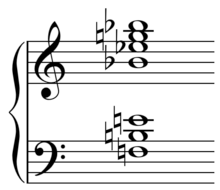Viennese trichord

The Viennese trichord.  Play
Play
| Component intervals from root | |
|---|---|
| tritone | |
| minor second | |
| root | |
| Tuning | |
| 8:12:17[1] | |
| Forte no. / | |
|
3-5 / | |
| Interval vector | |
| <1,0,0,0,1,1> |

Viennese trichord as dominant  Play .
Play .

A Viennese trichord as a part of 6-Z17, an altered dominant tritone substitution (Db7alt) in the key of C, from Bill Evans's opening to "What Is This Thing Called Love?"[3]  Play .
Play .
In music theory, a Viennese trichord (also Viennese fourth chord and tritone-fourth chord[2]), named for the Second Viennese School, is prime form <0,1,6>. It has Forte # 3-5.
As opposed to Hindemith and 037 (![]() Play ), "Composers such as Webern ... are partial to 016 trichords, given their 'more dissonant' inclusion of ics 1 and 6."[4]
Play ), "Composers such as Webern ... are partial to 016 trichords, given their 'more dissonant' inclusion of ics 1 and 6."[4]
In jazz and popular music, the chord usually has a dominant function, being the third, seventh, and added sixth/thirteenth of a dominant chord with elided root[3] (and fifth, see jazz chord).
Sources
- ↑ Paddison, Max and Deliège, Irène (2010). Contemporary Music: Theoretical and Philosophical Perspectives, p.62. ISBN 9781409404163.
- 1 2 DeLone, et al (1975). Aspects of 20th Century Music, p.348. ISBN 0-13-049346-5.
- 1 2 Forte, Allen (2000). "Harmonic Relations: American Popular Harmonies (1925-1950) and Their European Kin", pp. 5-36, Traditions, Institutions, and American Popular Music (Contemporary Music Review, Vol. 19, Part 1), p. 7. Routledge. Covach, John and Everett, Walter; eds. ISBN 90-5755-120-9.
- ↑ Henry Martin (Winter, 2000). "Seven Steps to Heaven: A Species Approach to Twentieth-Century Analysis and Composition", p.149, Perspectives of New Music, Vol. 38, No. 1, pp. 129-168.
External links
- Jay Tomlin. "All About Set Theory", Java Set Theory Machine.
- "More on Set Theory", Flexistentialism.
This article is issued from Wikipedia - version of the 8/30/2016. The text is available under the Creative Commons Attribution/Share Alike but additional terms may apply for the media files.
